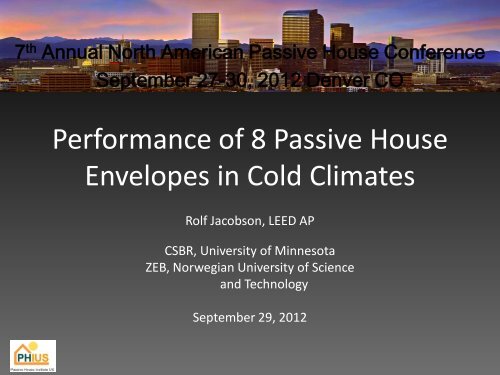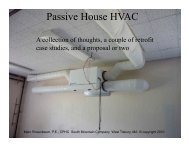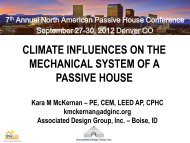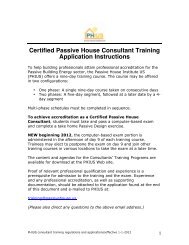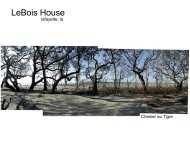Performance of 8 Passive House Envelopes in Cold Climates
Performance of 8 Passive House Envelopes in Cold Climates
Performance of 8 Passive House Envelopes in Cold Climates
- No tags were found...
Create successful ePaper yourself
Turn your PDF publications into a flip-book with our unique Google optimized e-Paper software.
7 th Annual North American <strong>Passive</strong> <strong>House</strong> Conference<br />
September 27-30, 2012 Denver CO<br />
<strong>Performance</strong> <strong>of</strong> 8 <strong>Passive</strong> <strong>House</strong><br />
<strong>Envelopes</strong> <strong>in</strong> <strong>Cold</strong> <strong>Climates</strong><br />
Rolf Jacobson, LEED AP<br />
CSBR, University <strong>of</strong> M<strong>in</strong>nesota<br />
ZEB, Norwegian University <strong>of</strong> Science<br />
and Technology<br />
September 29, 2012
7 th Annual North American <strong>Passive</strong> <strong>House</strong> Conference<br />
September 27-30, 2012 Denver CO<br />
Session Learn<strong>in</strong>g Objectives:<br />
• Understand the significance <strong>of</strong> accurately calculat<strong>in</strong>g R-values us<strong>in</strong>g 2-<br />
dimensional calculation protocols, and the benefits <strong>of</strong> us<strong>in</strong>g cont<strong>in</strong>uous<br />
<strong>in</strong>sulation for overall R-value performance.<br />
• Identify common l<strong>in</strong>ear thermal bridges <strong>in</strong> a residential envelope, and identify<br />
the steps that can be taken to m<strong>in</strong>imize thermal bridg<strong>in</strong>g at these locations.<br />
• Identify and understand the significance <strong>of</strong> an envelope’s “critical layer” <strong>in</strong><br />
terms <strong>of</strong> moisture performance. What steps can be taken to m<strong>in</strong>imize the risk<br />
<strong>of</strong> moisture damage and/or mold growth <strong>in</strong> the critical layer<br />
• Develop a general understand<strong>in</strong>g <strong>of</strong> the embodied energy and embodied<br />
carbon <strong>in</strong> common envelope materials. Answer the question <strong>of</strong> whether or<br />
not <strong>Passive</strong> <strong>House</strong> envelopes built with these materials exhibit life-cycle<br />
carbon sav<strong>in</strong>gs and energy sav<strong>in</strong>gs compared to standard homes
Outl<strong>in</strong>e<br />
1. Background<br />
2. Review<br />
3. Case studies & envelope selection<br />
4. Section 1 – 2-D R-value calculations<br />
5. Section 2 – Thermal bridg<strong>in</strong>g (THERM simulations)<br />
6. Section 3 – Hygrothermal performance (WUFI simulations)<br />
7. Section 4 – Life cycle environmental impacts (Athena models)
Outl<strong>in</strong>e<br />
1. Background<br />
2. Review<br />
3. Case studies & envelope selection<br />
4. Section 1 – 2-D R-value calculations<br />
5. Section 2 – Thermal bridg<strong>in</strong>g (THERM simulations)<br />
6. Section 3 – Hygrothermal performance (WUFI simulations)<br />
7. Section 4 – Life cycle environmental impacts (Athena models)<br />
The goal is not to pick a w<strong>in</strong>ner, but to use the comparison to<br />
<strong>in</strong>vestigate issues common to all passive house envelopes. Also,<br />
to highlight the strengths and weaknesses <strong>of</strong> different envelope<br />
types.
Background<br />
• B.A. <strong>in</strong> physics and math from St. Olaf College, 2001<br />
• Worked as a framer build<strong>in</strong>g homes from 2002 - 2005<br />
• Began work on Master’s thesis <strong>in</strong> 2007<br />
• Fulbright scholarship to complete thesis and study cold climate<br />
envelopes <strong>in</strong> Norway <strong>in</strong> 2010/2011<br />
<strong>Performance</strong> <strong>of</strong> 8 <strong>Passive</strong> <strong>House</strong> <strong>Envelopes</strong> <strong>in</strong> <strong>Cold</strong> <strong>Climates</strong> February 22, 2012
Background<br />
• In Norway, studied at the Center for Zero Emissions Build<strong>in</strong>gs (ZEB)<br />
• <strong>House</strong>d with<strong>in</strong> the Norwegian technical<br />
university, NTNU, <strong>in</strong> Trondheim<br />
• ZEB has close ties with SINTEF Byygforsk –<br />
SINTEF is similar to the Build<strong>in</strong>gs<br />
Technology Center (BTC) at ORNL, but<br />
greater cooperation between <strong>in</strong>dustry<br />
and university research. Also responsible<br />
for national build<strong>in</strong>g/energy code<br />
development.<br />
<strong>Performance</strong> <strong>of</strong> 8 <strong>Passive</strong> <strong>House</strong> <strong>Envelopes</strong> <strong>in</strong> <strong>Cold</strong> <strong>Climates</strong> February 22, 2012
Review – “<strong>Cold</strong> Climate” - for these purposes,<br />
primarily Climate Zones 6,7, plus Scand<strong>in</strong>avia<br />
<strong>Performance</strong> <strong>of</strong> 8 <strong>Passive</strong> <strong>House</strong> <strong>Envelopes</strong> <strong>in</strong> <strong>Cold</strong> <strong>Climates</strong> February 22, 2012
Review- climate comparison<br />
Kirkenes<br />
Arctic<br />
circle<br />
Trondheim<br />
Bergen<br />
Lillehammer<br />
Oslo<br />
<strong>Performance</strong> <strong>of</strong> 8 <strong>Passive</strong> <strong>House</strong> <strong>Envelopes</strong> <strong>in</strong> <strong>Cold</strong> <strong>Climates</strong> February 22, 2012
Case Studies – IECC climate zone 5,6<br />
<strong>Performance</strong> <strong>of</strong> 8 <strong>Passive</strong> <strong>House</strong> <strong>Envelopes</strong> <strong>in</strong> <strong>Cold</strong> <strong>Climates</strong> February 22, 2012
Case Studies – IECC climate zone 6<br />
<strong>Performance</strong> <strong>of</strong> 8 <strong>Passive</strong> <strong>House</strong> <strong>Envelopes</strong> <strong>in</strong> <strong>Cold</strong> <strong>Climates</strong> February 22, 2012
Case Studies – IECC climate zone 7<br />
<strong>Performance</strong> <strong>of</strong> 8 <strong>Passive</strong> <strong>House</strong> <strong>Envelopes</strong> <strong>in</strong> <strong>Cold</strong> <strong>Climates</strong> February 22, 2012
Case Studies – Scand<strong>in</strong>avian climates<br />
<strong>Performance</strong> <strong>of</strong> 8 <strong>Passive</strong> <strong>House</strong> <strong>Envelopes</strong> <strong>in</strong> <strong>Cold</strong> <strong>Climates</strong> February 22, 2012
Case Studies – Scand<strong>in</strong>avian climates<br />
Average R-values <strong>of</strong> cold-climate <strong>Passive</strong> <strong>House</strong> case studies<br />
• Above grade wall: R-62.9 Target: R-60<br />
• Ro<strong>of</strong>: R-83.8 Target: R-80<br />
• Floor slab: R-67 Target: R-60<br />
Average air tightness<br />
• 0.46 ACH @50Pa Requirement: 0.6<br />
<strong>Performance</strong> <strong>of</strong> 8 <strong>Passive</strong> <strong>House</strong> <strong>Envelopes</strong> <strong>in</strong> <strong>Cold</strong> <strong>Climates</strong> February 22, 2012
Case Studies – results and comparison<br />
Envelope:<br />
• Walls – R-60<br />
(4x higher)<br />
R-60<br />
R-80<br />
R-60<br />
• Ro<strong>of</strong> = R-80<br />
(2x higher)<br />
reference IEC<br />
• Floor slab = R-60<br />
(6x higher)<br />
R-7<br />
<strong>Performance</strong> <strong>of</strong> 8 <strong>Passive</strong> <strong>House</strong> <strong>Envelopes</strong> <strong>in</strong> <strong>Cold</strong> <strong>Climates</strong> February 22, 2012
High <strong>Performance</strong> <strong>Envelopes</strong><br />
What are the concerns<br />
• Will the embodied energy and carbon neutralize the sav<strong>in</strong>gs<br />
• With <strong>in</strong>creased <strong>in</strong>sulation and airtightness, is there <strong>in</strong>creased<br />
risk <strong>of</strong> mold and moisture problems – (hygrothermal performance)<br />
• What is a “thermal bridge-free” detail<br />
• Unfamiliarity – what R-values are really required <strong>in</strong> this<br />
climate, and how should they be calculated<br />
• What types <strong>of</strong> envelopes work best<br />
<strong>Performance</strong> <strong>of</strong> 8 <strong>Passive</strong> <strong>House</strong> <strong>Envelopes</strong> <strong>in</strong> <strong>Cold</strong> <strong>Climates</strong> February 22, 2012
Double stud<br />
2x4 studs, 16” o.c. spac<strong>in</strong>g<br />
truss ro<strong>of</strong>, 24” o.c. spac<strong>in</strong>g<br />
asphalt sh<strong>in</strong>gles<br />
ro<strong>of</strong><strong>in</strong>g paper<br />
0.5” OSB<br />
ventilated “cold attic”<br />
back-ventilated<br />
cladd<strong>in</strong>g<br />
weather barrier<br />
0.75” fiberboard<br />
sheath<strong>in</strong>g<br />
16” blown cellulose, R – 3.8/<strong>in</strong>ch<br />
19.5” blown<br />
cellulose,<br />
R – 3.8/<strong>in</strong>ch<br />
0.5” OSB (air barrier/<br />
vapor retarder<br />
0.5” gypsum<br />
0.5” OSB (air barrier/vapor retarder)<br />
0.5” gypsum<br />
Double Stud<br />
Frame<br />
<strong>Performance</strong> <strong>of</strong> 8 <strong>Passive</strong> <strong>House</strong> <strong>Envelopes</strong> <strong>in</strong> <strong>Cold</strong> <strong>Climates</strong> February 22, 2012
TJI Frame (I-joist)<br />
16” TJI “studs”, 24” o.c. spac<strong>in</strong>g<br />
20” TJI ro<strong>of</strong> joists, 24” o.c. spac<strong>in</strong>g<br />
asphalt sh<strong>in</strong>gles<br />
ro<strong>of</strong><strong>in</strong>g paper<br />
0.5” OSB<br />
1.5” ventilated air gap<br />
weather barrier<br />
back-ventilated<br />
cladd<strong>in</strong>g<br />
weather barrier<br />
0.75” fiberboard<br />
sheath<strong>in</strong>g<br />
0.75” fiberboard<br />
sheath<strong>in</strong>g<br />
20” dense-pack<br />
fiberglass, R –4.35/<strong>in</strong>ch<br />
0.5” OSB (air barrier/<br />
vapor retarder<br />
16” dense-pack fiberglass<br />
R – 4.35/<strong>in</strong>ch<br />
0.5” OSB (air barrier/vapor retarder)<br />
0.5” gypsum<br />
TJI Frame<br />
0.5” gypsum<br />
<strong>Performance</strong> <strong>of</strong> 8 <strong>Passive</strong> <strong>House</strong> <strong>Envelopes</strong> <strong>in</strong> <strong>Cold</strong> <strong>Climates</strong> February 22, 2012
Advanced Frame with SPF<br />
2x6 studs, 24” o.c. spac<strong>in</strong>g<br />
truss ro<strong>of</strong>, 24” o.c. spac<strong>in</strong>g<br />
asphalt sh<strong>in</strong>gles<br />
ro<strong>of</strong><strong>in</strong>g paper<br />
0.5” OSB<br />
ventilated “cold attic”<br />
back-ventilated<br />
cladd<strong>in</strong>g<br />
weather barrier<br />
7” unfaced<br />
polyiso, R – 5.0/<strong>in</strong>ch<br />
0.5” OSB<br />
5.5” SPF, R – 6.2/<strong>in</strong>ch<br />
(air barrier/vapor retarder)<br />
0.5” gypsum<br />
19.5” blown<br />
cellulose,<br />
R – 3.8/<strong>in</strong>ch<br />
1” SPF, R – 6.2/<strong>in</strong>ch<br />
(air barrier/vap. retarder)<br />
0.625” gypsum<br />
Adv. Frame<br />
with SPF<br />
<strong>Performance</strong> <strong>of</strong> 8 <strong>Passive</strong> <strong>House</strong> <strong>Envelopes</strong> <strong>in</strong> <strong>Cold</strong> <strong>Climates</strong> February 22, 2012
Advanced Frame with cross strapp<strong>in</strong>g<br />
2x6 studs, 24” o.c. spac<strong>in</strong>g<br />
2x2 cross strapp<strong>in</strong>g<br />
truss ro<strong>of</strong>, 24” o.c. spac<strong>in</strong>g<br />
asphalt sh<strong>in</strong>gles<br />
ro<strong>of</strong><strong>in</strong>g paper<br />
0.5” OSB<br />
ventilated “cold attic”<br />
back-ventilated<br />
cladd<strong>in</strong>g<br />
weather barrier<br />
9.85” m<strong>in</strong>eral<br />
wool, R - 3.8/<strong>in</strong>ch<br />
0.5” OSB<br />
5.5” m<strong>in</strong>eral wool, R – 3.8/<strong>in</strong>ch<br />
polyethylene air barrier/vapor retarder<br />
1.5” m<strong>in</strong>eral wool, R – 3.8/<strong>in</strong>ch<br />
0.5” gypsum<br />
19.5” blown<br />
cellulose,<br />
R – 3.8/<strong>in</strong>ch<br />
polyethylene air<br />
barrier/vapor retarder<br />
1.5” m<strong>in</strong>eral wool,<br />
R – 3.8/<strong>in</strong>ch<br />
0.625” gypsum<br />
Adv. Frame w.<br />
Cross Strapp<strong>in</strong>g<br />
<strong>Performance</strong> <strong>of</strong> 8 <strong>Passive</strong> <strong>House</strong> <strong>Envelopes</strong> <strong>in</strong> <strong>Cold</strong> <strong>Climates</strong> February 22, 2012
Structural Insulated Panel (SIP)<br />
back-ventilated<br />
cladd<strong>in</strong>g<br />
weather barrier<br />
3” unfaced polyisocyanurate,<br />
R –5.0/<strong>in</strong>ch<br />
14.25” SIP panel (13.375” EPS),<br />
R – 4.0/<strong>in</strong>ch (air barrier/vapor retarder)<br />
0.5” gypsum<br />
asphalt sh<strong>in</strong>gles<br />
ro<strong>of</strong><strong>in</strong>g paper<br />
0.5” OSB<br />
1.5” ventilated air gap<br />
weather barrier<br />
4” unfaced polyiso,<br />
R – 5.0/<strong>in</strong>ch<br />
ro<strong>of</strong><strong>in</strong>g paper<br />
14.25” SIP<br />
(13.375” EPS), R-4.0/<strong>in</strong>ch<br />
(air barrier/vapor<br />
retarder)<br />
SIP panel<br />
0.5” gypsum<br />
<strong>Performance</strong> <strong>of</strong> 8 <strong>Passive</strong> <strong>House</strong> <strong>Envelopes</strong> <strong>in</strong> <strong>Cold</strong> <strong>Climates</strong> February 22, 2012
Massivtre/SEP panel<br />
“storage” truss ro<strong>of</strong>, 24” o.c. spac<strong>in</strong>g<br />
asphalt sh<strong>in</strong>gles<br />
ro<strong>of</strong><strong>in</strong>g paper<br />
0.5” OSB<br />
1.5” ventilated air gap<br />
back-ventilated<br />
cladd<strong>in</strong>g<br />
weather barrier<br />
(foil fac<strong>in</strong>g,<br />
jo<strong>in</strong>ts taped)<br />
9” foil-faced polyiso,<br />
R – 6.33/<strong>in</strong>ch<br />
bitumen ro<strong>of</strong><strong>in</strong>g membrane<br />
(air barrier/vapor retarder)<br />
1.5” OSB SEP panel<br />
12” foil-faced<br />
polyiso, R – 6.33/<strong>in</strong>ch<br />
0.5” gypsum<br />
bitumen ro<strong>of</strong><strong>in</strong>g membrane<br />
(air barrier/vapor retarder)<br />
Massivtre/<br />
SEP panel<br />
0.5 “ OSB<br />
<strong>Performance</strong> <strong>of</strong> 8 <strong>Passive</strong> <strong>House</strong> <strong>Envelopes</strong> <strong>in</strong> <strong>Cold</strong> <strong>Climates</strong> February 22, 2012
Insulated Concrete Form (ICF)<br />
2.5” gravel ballast<br />
EPDM ro<strong>of</strong> membrane<br />
16” polyisocyanurate,<br />
R – 5.0/<strong>in</strong>ch<br />
vapor retarder<br />
EIFS stucco<br />
f<strong>in</strong>ish<br />
10” EPS,<br />
R – 4.0/<strong>in</strong>ch<br />
11” ICF (6” concrete,<br />
2 EPS layers @ 2.5”),<br />
R – 4.0/<strong>in</strong>ch<br />
(air barrier/vapor retarder)<br />
0.5” gypsum<br />
2” concrete<br />
structural topp<strong>in</strong>g<br />
(air barrier)<br />
6” concrete<br />
hollow-core plank<br />
3.5” air gap<br />
0.5” gypsum<br />
Insulated Concrete<br />
Form (ICF)<br />
<strong>Performance</strong> <strong>of</strong> 8 <strong>Passive</strong> <strong>House</strong> <strong>Envelopes</strong> <strong>in</strong> <strong>Cold</strong> <strong>Climates</strong> February 22, 2012
Mass wall<br />
truss ro<strong>of</strong>, 24” o.c. spac<strong>in</strong>g<br />
asphalt sh<strong>in</strong>gles<br />
ro<strong>of</strong><strong>in</strong>g paper<br />
0.5” OSB<br />
ventilated “cold attic”<br />
back-ventilated<br />
4” brick<br />
14” m<strong>in</strong>eral<br />
wool (Murfilt),<br />
R – 4.2/<strong>in</strong>ch<br />
6” concrete<br />
(air barrier/vapor retarder)<br />
21.5” blown<br />
cellulose,<br />
R – 3.8/<strong>in</strong>ch<br />
polyethylene air<br />
barrier/vapor retarder<br />
0.625” gypsum<br />
0.5” gypsum<br />
Mass wall<br />
<strong>Performance</strong> <strong>of</strong> 8 <strong>Passive</strong> <strong>House</strong> <strong>Envelopes</strong> <strong>in</strong> <strong>Cold</strong> <strong>Climates</strong> February 22, 2012
Base case standard frame<br />
2x6 studs, 16” o.c. spac<strong>in</strong>g<br />
truss ro<strong>of</strong>, 24” o.c. spac<strong>in</strong>g<br />
asphalt sh<strong>in</strong>gles<br />
ro<strong>of</strong><strong>in</strong>g paper<br />
0.5” OSB<br />
ventilated “cold attic”<br />
v<strong>in</strong>yl cladd<strong>in</strong>g<br />
weather barrier<br />
12” blown<br />
cellulose,<br />
R – 3.8/<strong>in</strong>ch<br />
polyethylene air<br />
barrier/vapor retarder<br />
0.5” OSB<br />
5.5” fiberglass batt, R – 3.3/<strong>in</strong>ch<br />
polyethylene air barrier/vapor retarder<br />
0.5” gypsum<br />
0.625” gypsum<br />
Base Case<br />
Standard Frame<br />
<strong>Performance</strong> <strong>of</strong> 8 <strong>Passive</strong> <strong>House</strong> <strong>Envelopes</strong> <strong>in</strong> <strong>Cold</strong> <strong>Climates</strong> February 22, 2012
Section 1 – 2-D R-value calculations<br />
• Center <strong>of</strong> cavity R-value – the R-value calculated through the<br />
center <strong>of</strong> the wall, with no fram<strong>in</strong>g. (R-19) Very <strong>in</strong>accurate.<br />
• Clear wall R-value – the R-value calculated for a “clear” section<br />
<strong>of</strong> the wall (no w<strong>in</strong>dows, doors, other penetrations), <strong>in</strong>cludes<br />
fram<strong>in</strong>g, which can make up 25% <strong>of</strong> the wall area <strong>in</strong> typical<br />
residential construction. (R-16) This is the typical “parallel paths”<br />
or “UA method” used <strong>in</strong> U.S.<br />
• 2-D R-value – based on the “clear wall” calculation, but adds<br />
lateral heat flow <strong>in</strong> the wall. Takes <strong>in</strong>to account extra heat loss due<br />
to 2-dimensional flow <strong>of</strong> heat through thermal bridges such as studs .<br />
(R-15.5) Follows EN ISO 6946<br />
<strong>Performance</strong> <strong>of</strong> 8 <strong>Passive</strong> <strong>House</strong> <strong>Envelopes</strong> <strong>in</strong> <strong>Cold</strong> <strong>Climates</strong> February 22, 2012
Section 1 – 2-D R-value calculations<br />
to achieve R-60<br />
Wall models are<br />
assembled us<strong>in</strong>g<br />
thicknesses <strong>of</strong> actual<br />
construction products<br />
and achieve R-60 (with<br />
some variation).<br />
<strong>Performance</strong> <strong>of</strong> 8 <strong>Passive</strong> <strong>House</strong> <strong>Envelopes</strong> <strong>in</strong> <strong>Cold</strong> <strong>Climates</strong> February 22, 2012
Section 1 – 2-D R-value calculations<br />
F<strong>in</strong>al 2-D R-value<br />
divided by center <strong>of</strong><br />
cavity R-value.<br />
Shows the percentage<br />
reduction <strong>in</strong> R-value<br />
due to repetitive<br />
thermal bridges such<br />
as studs, plates,<br />
spl<strong>in</strong>es, etc.<br />
<strong>Performance</strong> <strong>of</strong> 8 <strong>Passive</strong> <strong>House</strong> <strong>Envelopes</strong> <strong>in</strong> <strong>Cold</strong> <strong>Climates</strong> February 22, 2012
Section 2 – Thermal Bridge Analysis<br />
Thermal bridges<br />
ro<strong>of</strong>/wall<br />
<strong>in</strong>tersection<br />
• repetitive bridges – already accounted for!<br />
• po<strong>in</strong>t bridges – heat loss too small to consider<br />
rim joist<br />
• l<strong>in</strong>ear bridges – heat loss should be calculated<br />
Circled areas are common<br />
l<strong>in</strong>ear thermal bridges<br />
wall/foundation<br />
<strong>in</strong>tersection<br />
Image from David White,<br />
Right Environments, 2010<br />
<strong>Performance</strong> <strong>of</strong> 8 <strong>Passive</strong> <strong>House</strong> <strong>Envelopes</strong> <strong>in</strong> <strong>Cold</strong> <strong>Climates</strong> February 22, 2012
Section 2 – Thermal Bridge Analysis<br />
Image from David White,<br />
Right Environments, 2010<br />
The thermal bridge heat loss is the difference between the “true”<br />
heat loss, calculated us<strong>in</strong>g 2-dimensional simulation (THERM), and<br />
the heat loss calculated us<strong>in</strong>g the typical U·A method.<br />
<strong>Performance</strong> <strong>of</strong> 8 <strong>Passive</strong> <strong>House</strong> <strong>Envelopes</strong> <strong>in</strong> <strong>Cold</strong> <strong>Climates</strong> February 22, 2012
Section 2 – Thermal Bridge Analysis<br />
10 locations (but no w<strong>in</strong>dow t.bridges), 8 different envelope types<br />
Thermal Bridge Location<br />
Adv Frame w<br />
cross strap<br />
Adv Frame w<br />
SPF Double Stud TJI Frame ICF Mass wall SEP panel SIP panel<br />
Average psi value<br />
<strong>of</strong> TB location<br />
1. Exterior wall corner<br />
1 above grade -0.054 -0.039 -0.058 -0.051 -0.051 -0.064 -0.036 -0.045 -0.050<br />
2<br />
2. Foundation wall<br />
corner below grade -0.062 -0.062 -0.062 -0.062 -0.051 -0.075 -0.062 -0.062 -0.062<br />
3<br />
3. Exterior wall corner<br />
with foundation wall -0.062 -0.056 -0.060 -0.064 -0.051 -0.075 -0.051 -0.061 -0.060<br />
4<br />
4. Wall to ro<strong>of</strong> corner at<br />
gable wall -0.054 -0.069 -0.059 -0.051 0.042 -0.061 -0.037 -0.049 -0.042<br />
5<br />
5. Wall to ro<strong>of</strong> corner at<br />
side (bear<strong>in</strong>g) wall -0.054 -0.069 -0.059 -0.018 0.042 -0.058 -0.014 -0.017 -0.031<br />
6<br />
6. Ro<strong>of</strong> peak (l<strong>of</strong>ted<br />
envelopes only) - - - -0.052 - - -0.034 -0.047 -0.044<br />
7<br />
7. Rim joist on<br />
foundation wall 0.010 0.003 0.006 0.006 0.003 0.000 0.003 0.009 0.005<br />
8<br />
8. Rim joist on above<br />
grade wall 0.006 0.005 0.006 -0.001 0.003 0.000 -0.001 0.009 0.003<br />
9<br />
9. Floor slab to<br />
foundation wall<br />
<strong>in</strong>tersection below -0.021 -0.021 -0.021 -0.021 -0.005 0.008 0.034 0.034 -0.002<br />
10<br />
10. Floor slab to exterior<br />
wall <strong>in</strong>tersection at<br />
grade 0.005 0.008 -0.001 0.009 0.006 0.006 0.023 0.052 0.014<br />
Average psi value <strong>of</strong><br />
envelope -0.032 -0.033 -0.034 -0.030 -0.007 -0.036 -0.017 -0.018<br />
<strong>Passive</strong> <strong>House</strong> guidel<strong>in</strong>e, Ψ
Section 2 – Thermal Bridge Analysis<br />
Average Ψ values for each detail location across all envelope types<br />
<strong>Performance</strong> <strong>of</strong> 8 <strong>Passive</strong> <strong>House</strong> <strong>Envelopes</strong> <strong>in</strong> <strong>Cold</strong> <strong>Climates</strong> February 22, 2012
Section 2 – Thermal Bridge Analysis<br />
Average Ψ values for each detail location across all envelope types<br />
<strong>Performance</strong> <strong>of</strong> 8 <strong>Passive</strong> <strong>House</strong> <strong>Envelopes</strong> <strong>in</strong> <strong>Cold</strong> <strong>Climates</strong> February 22, 2012
Section 2 – Thermal Bridge Analysis<br />
Average Ψ values for each detail location across all envelope types<br />
<strong>Performance</strong> <strong>of</strong> 8 <strong>Passive</strong> <strong>House</strong> <strong>Envelopes</strong> <strong>in</strong> <strong>Cold</strong> <strong>Climates</strong> February 22, 2012
Section 2 – Thermal Bridge Analysis<br />
Double stud frame: Ψ = - 0.058 W/mK<br />
TJI frame: Ψ = - 0.051 W/mK<br />
Both walls are the same thickness and have the same R-value.<br />
Both details easily pass the Ψ
Section 2 – Thermal Bridge Analysis<br />
SEP panel rim joist: Ψ = 0.003 W/mK<br />
SIP panel rim joist: Ψ = 0.009 W/mK<br />
SEP panel wall’s external <strong>in</strong>sulation is aligned with basement wall’s external <strong>in</strong>sulation<br />
Only SEP detail easily passes the Ψ
Section 2 – Thermal Bridge Analysis<br />
SEP panel FPSF: Ψ = 0.023 W/mK<br />
SIP panel FPSF: Ψ = 0.052 W/mK<br />
SEP panel wall’s external <strong>in</strong>sulation is better aligned, and Ψ value is much better,<br />
But neither detail comes close to pass<strong>in</strong>g the Ψ
Section 2 – Thermal Bridge Analysis<br />
ICF foot<strong>in</strong>g: Ψ = 0.005 W/mK<br />
Foamglas block foot<strong>in</strong>g: Ψ = 0.006 W/mK<br />
Both ICF foot<strong>in</strong>g and Foamglas block foot<strong>in</strong>g perform much better than the FPSF<br />
Both details pass the Ψ
Section 3 – Hygrothermal Analysis<br />
What are we worried about<br />
Moisture levels <strong>in</strong> highly <strong>in</strong>sulated envelopes<br />
• Mold growth<br />
• Indoor air quality<br />
• Durability <strong>of</strong> structure<br />
In general, relative humidity<br />
above 80% comb<strong>in</strong>ed with<br />
temperatures above freez<strong>in</strong>g<br />
can <strong>in</strong>itiate mold growth on<br />
wood/cellulose.<br />
<strong>Performance</strong> <strong>of</strong> 8 <strong>Passive</strong> <strong>House</strong> <strong>Envelopes</strong> <strong>in</strong> <strong>Cold</strong> <strong>Climates</strong> February 22, 2012
Section 3 – Hygrothermal Analysis<br />
Mold growth potential<br />
<strong>Passive</strong> <strong>House</strong> air<br />
leakage limit, 0.6 ACH<br />
Average new MN home<br />
air leakage, 2.5 ACH<br />
Insulation<br />
thickness<br />
20 <strong>in</strong>ches<br />
14 <strong>in</strong>ches<br />
10 <strong>in</strong>ches<br />
6 <strong>in</strong>ches<br />
S. Uvsløkk, 2011<br />
Air leakage, ACH @50Pa<br />
Increas<strong>in</strong>g <strong>in</strong>sulation thickness without improv<strong>in</strong>g air tightness <strong>in</strong>creases the risk <strong>of</strong> mold.<br />
But construct<strong>in</strong>g an airtight 0.6 ACH @ 50Pa passive house envelope with 20 <strong>in</strong>ches <strong>of</strong><br />
<strong>in</strong>sulation actually reduces the risk <strong>of</strong> mold growth on wood sheath<strong>in</strong>g.<br />
<strong>Performance</strong> <strong>of</strong> 8 <strong>Passive</strong> <strong>House</strong> <strong>Envelopes</strong> <strong>in</strong> <strong>Cold</strong> <strong>Climates</strong> February 22, 2012
Section 3 – Hygrothermal Analysis<br />
How do you track potential for mold growth<br />
• No need to monitor every layer <strong>in</strong> the envelope for temperature and RH.<br />
• Determ<strong>in</strong>e the “critical layer(s)” and monitor temperature and RH levels<br />
there<br />
• Generally, the critical layer is the first condens<strong>in</strong>g surface (must be cold, at<br />
or below the dewpo<strong>in</strong>t) encountered by outward migrat<strong>in</strong>g moisture. Must<br />
also conta<strong>in</strong> organic nutrients such as cellulose that support mold growth.<br />
• Wood sheath<strong>in</strong>g is commonly the critical layer <strong>in</strong> residential assemblies.<br />
• What temperatures and RH levels are required<br />
<strong>Performance</strong> <strong>of</strong> 8 <strong>Passive</strong> <strong>House</strong> <strong>Envelopes</strong> <strong>in</strong> <strong>Cold</strong> <strong>Climates</strong> February 22, 2012
Section 3 – Hygrothermal Analysis<br />
Risk l<strong>in</strong>es for mold growth on wood<br />
week<br />
weeks<br />
RH %<br />
weeks<br />
weeks<br />
weeks<br />
32 50 68 86 104<br />
Temperature<br />
Skanska AB, Tengberg, 2010<br />
In the most general terms, it takes temperatures above freez<strong>in</strong>g and RH above 80% to<br />
<strong>in</strong>itiate mold growth on wood. Higher RH levels lead to mold growth <strong>in</strong> shorter time spans.<br />
<strong>Cold</strong>er temperatures slow down mold growth.<br />
<strong>Performance</strong> <strong>of</strong> 8 <strong>Passive</strong> <strong>House</strong> <strong>Envelopes</strong> <strong>in</strong> <strong>Cold</strong> <strong>Climates</strong> February 22, 2012
Section 3 – Hygrothermal Analysis<br />
100.0<br />
90.0<br />
Double stud wall, 12 week averages<br />
Relative Humidity (%)<br />
80.0<br />
70.0<br />
60.0<br />
50.0<br />
40.0<br />
30.0<br />
20.0<br />
-10.0 0.0 10.0 20.0 30.0<br />
Temperature (Celsius)<br />
Critical layer = fiberboard sheath<strong>in</strong>g, no exterior<br />
<strong>in</strong>sulation<br />
What happens when we add exterior <strong>in</strong>sulation<br />
<strong>Performance</strong> <strong>of</strong> 8 <strong>Passive</strong> <strong>House</strong> <strong>Envelopes</strong> <strong>in</strong> <strong>Cold</strong> <strong>Climates</strong> February 22, 2012
Section 3 – Hygrothermal Analysis<br />
Double stud wall, 12 week averages<br />
Adv. frame w cross strap 12 wk. avg.<br />
100.0<br />
100.0<br />
90.0<br />
90.0<br />
80.0<br />
80.0<br />
Relative Humidity (%)<br />
70.0<br />
60.0<br />
50.0<br />
Relative Humidity (%)<br />
70.0<br />
60.0<br />
50.0<br />
40.0<br />
40.0<br />
30.0<br />
30.0<br />
20.0<br />
-10.0 0.0 10.0 20.0 30.0<br />
Temperature (Celsius)<br />
20.0<br />
-10.0 0.0 10.0 20.0 30.0<br />
Temperature (Celsius)<br />
Critical layer = fiberboard sheath<strong>in</strong>g, no exterior<br />
<strong>in</strong>sulation<br />
Critical layer = OSB sheath<strong>in</strong>g, beneath 10”<br />
<strong>of</strong> m<strong>in</strong>eral wool<br />
What happens when we add exterior <strong>in</strong>sulation<br />
Temperatures <strong>in</strong> the critical layer go up, heat drives <strong>of</strong>f excess moisture.<br />
<strong>Performance</strong> <strong>of</strong> 8 <strong>Passive</strong> <strong>House</strong> <strong>Envelopes</strong> <strong>in</strong> <strong>Cold</strong> <strong>Climates</strong> February 22, 2012
Section 3 – Hygrothermal Analysis<br />
SIP wall, 12 week averages<br />
100.0<br />
90.0<br />
Relative Humidity (%)<br />
80.0<br />
70.0<br />
60.0<br />
50.0<br />
40.0<br />
30.0<br />
20.0<br />
-10.0 0.0 10.0 20.0 30.0 40.0<br />
Temperature (Celsius)<br />
Critical layer = OSB sheath<strong>in</strong>g, beneath 3” unfaced polyiso<br />
What happens if the exterior <strong>in</strong>sulation is not vapor permeable (such as XPS)<br />
<strong>Performance</strong> <strong>of</strong> 8 <strong>Passive</strong> <strong>House</strong> <strong>Envelopes</strong> <strong>in</strong> <strong>Cold</strong> <strong>Climates</strong> February 22, 2012
Section 3 – Hygrothermal Analysis<br />
SIP wall, 12 week averages<br />
SIP wall variant, 12 week averages<br />
100.0<br />
100.0<br />
90.0<br />
90.0<br />
80.0<br />
80.0<br />
Relative Humidity (%)<br />
70.0<br />
60.0<br />
50.0<br />
Relative Humidity (%)<br />
70.0<br />
60.0<br />
50.0<br />
40.0<br />
40.0<br />
30.0<br />
30.0<br />
20.0<br />
-10.0 0.0 10.0 20.0 30.0 40.0<br />
Temperature (Celsius)<br />
20.0<br />
-10.0 0.0 10.0 20.0 30.0 40.0<br />
Temperature (Celsius)<br />
Critical layer = OSB sheath<strong>in</strong>g, beneath 3” unfaced polyiso<br />
(perm rat<strong>in</strong>g = 4 @ 1 <strong>in</strong>ch thickness)<br />
Critical layer = OSB sheath<strong>in</strong>g, beneath 3” XPS<br />
(perm rat<strong>in</strong>g = 0.75 @ 1 <strong>in</strong>ch thickness)<br />
What happens if the exterior <strong>in</strong>sulation is not vapor permeable (such as XPS)<br />
Despite heat, dry<strong>in</strong>g is reduced and you may end up with a wetter critical layer!<br />
<strong>Performance</strong> <strong>of</strong> 8 <strong>Passive</strong> <strong>House</strong> <strong>Envelopes</strong> <strong>in</strong> <strong>Cold</strong> <strong>Climates</strong> February 22, 2012
Section 3 – Hygrothermal Analysis<br />
100.0<br />
ICF wall, 12 week averages<br />
Is this assembly moisture safe<br />
90.0<br />
80.0<br />
Relative Humidity (%)<br />
70.0<br />
60.0<br />
50.0<br />
40.0<br />
30.0<br />
20.0<br />
-10.0 0.0 10.0 20.0 30.0<br />
Temperature (Celsius)<br />
<strong>Performance</strong> <strong>of</strong> 8 <strong>Passive</strong> <strong>House</strong> <strong>Envelopes</strong> <strong>in</strong> <strong>Cold</strong> <strong>Climates</strong> February 22, 2012
Section 3 – Hygrothermal Analysis<br />
Relative Humidity (%)<br />
100.0<br />
90.0<br />
80.0<br />
70.0<br />
60.0<br />
50.0<br />
ICF wall, 12 week averages<br />
Is this assembly moisture safe<br />
• no “critical layer” <strong>in</strong> an ICF<br />
assembly, risk l<strong>in</strong>e doesn’t<br />
apply<br />
• data taken 0.5” from exterior<br />
surface<br />
40.0<br />
30.0<br />
20.0<br />
-10.0 0.0 10.0 20.0 30.0<br />
Temperature (Celsius)<br />
• what about wood materials<br />
put <strong>in</strong>to the wall<br />
• what about R-value<br />
performance <strong>of</strong> the EPS<br />
<strong>Performance</strong> <strong>of</strong> 8 <strong>Passive</strong> <strong>House</strong> <strong>Envelopes</strong> <strong>in</strong> <strong>Cold</strong> <strong>Climates</strong> February 22, 2012
Section 3 – Hygrothermal Analysis<br />
Summary – what are the take-away messages here<br />
• Know the vapor permeance <strong>of</strong> the materials <strong>in</strong> your envelope. The<br />
colder the climate, the more important a warm-side vapor retarder<br />
becomes.<br />
• Several <strong>in</strong>ches <strong>of</strong> permeable exterior <strong>in</strong>sulation is a good idea to warm<br />
the critical layer and reduce mold growth risks.<br />
• Or elim<strong>in</strong>ate the critical layer with an assembly (such as ICF) that does<br />
not support mold growth and is relatively impervious to moisture.<br />
• Hit the air tightness target (0.6 ACH @50Pa)!<br />
<strong>Performance</strong> <strong>of</strong> 8 <strong>Passive</strong> <strong>House</strong> <strong>Envelopes</strong> <strong>in</strong> <strong>Cold</strong> <strong>Climates</strong> February 22, 2012
Section 4 – Life Cycle Env. Impacts<br />
Life cycle environmental impacts <strong>of</strong> the envelope materials:<br />
• Measured us<strong>in</strong>g Athena Environmental Impact Estimator<br />
• Athena’s “life cycle” <strong>in</strong>cludes raw material extraction/m<strong>in</strong><strong>in</strong>g, transportation,<br />
process<strong>in</strong>g, product fabrication, distribution, ma<strong>in</strong>tenance, and disposal<br />
• Entire envelopes were modeled, ensur<strong>in</strong>g “functional equivalence”<br />
• Results measured <strong>in</strong> terms <strong>of</strong> 8 environmental <strong>in</strong>dicators such as embodied<br />
energy, global warm<strong>in</strong>g potential, weighted resource use, eutrophication, etc.<br />
These <strong>in</strong>dicators represent a comprehensive view <strong>of</strong> the impact on the<br />
environment<br />
<strong>Performance</strong> <strong>of</strong> 8 <strong>Passive</strong> <strong>House</strong> <strong>Envelopes</strong> <strong>in</strong> <strong>Cold</strong> <strong>Climates</strong> February 22, 2012
Section 4 – Life Cycle Env. Impacts<br />
180<br />
160<br />
140<br />
Life cycle weighted resource<br />
use <strong>of</strong> above grade walls by<br />
build<strong>in</strong>g element<br />
Weighted Resource Use (lbs)<br />
120<br />
100<br />
80<br />
60<br />
40<br />
20<br />
Vapor retarder/air barrier<br />
Exterior cladd<strong>in</strong>g<br />
Interior f<strong>in</strong>ish material<br />
Insulation<br />
Structure<br />
• concrete, brick and<br />
m<strong>in</strong>eral wool have large<br />
impacts<br />
• <strong>in</strong>sulation <strong>in</strong> general has<br />
the smallest impact (it’s<br />
mostly air)<br />
0<br />
<strong>Performance</strong> <strong>of</strong> 8 <strong>Passive</strong> <strong>House</strong> <strong>Envelopes</strong> <strong>in</strong> <strong>Cold</strong> <strong>Climates</strong> February 22, 2012
Section 4 – Life Cycle Env. Impacts<br />
180<br />
160<br />
140<br />
Life cycle embodied energy<br />
<strong>of</strong> above grade walls by<br />
build<strong>in</strong>g element<br />
Primary Energy (kBTU)<br />
120<br />
100<br />
80<br />
60<br />
40<br />
Vapor retarder/air barrier<br />
Exterior cladd<strong>in</strong>g<br />
Interior f<strong>in</strong>ish material<br />
Insulation<br />
Structure<br />
• m<strong>in</strong>eral wool and foam<br />
<strong>in</strong>sulation have quite a bit<br />
<strong>of</strong> embodied energy<br />
• fiberglass is better, but<br />
cellulose is best<br />
20<br />
0<br />
• Concrete, brick, v<strong>in</strong>yl<br />
sid<strong>in</strong>g and bitumen<br />
ro<strong>of</strong><strong>in</strong>g membrane also<br />
have large embodied<br />
energy<br />
<strong>Performance</strong> <strong>of</strong> 8 <strong>Passive</strong> <strong>House</strong> <strong>Envelopes</strong> <strong>in</strong> <strong>Cold</strong> <strong>Climates</strong> February 22, 2012
Section 4 – Life Cycle Env. Impacts<br />
100<br />
Life cycle global warm<strong>in</strong>g<br />
potential <strong>of</strong> the envelope<br />
materials:<br />
GWP (lbs CO2 equivalent)<br />
80<br />
60<br />
40<br />
20<br />
0<br />
Vapor retarder/air barrier<br />
Exterior cladd<strong>in</strong>g<br />
Interior f<strong>in</strong>ish material<br />
Insulation<br />
Structure<br />
• concrete, EPS, brick, and<br />
m<strong>in</strong>eral wool have high<br />
GWP, but…<br />
• spray polyurethane foam<br />
blown with HFC blow<strong>in</strong>g<br />
agents has almost 100x<br />
greater GWP than<br />
fiberglass per unit area<br />
per R-value<br />
Similar effects are seen with<br />
XPS! – all XPS removed from<br />
envelopes.<br />
<strong>Performance</strong> <strong>of</strong> 8 <strong>Passive</strong> <strong>House</strong> <strong>Envelopes</strong> <strong>in</strong> <strong>Cold</strong> <strong>Climates</strong> February 22, 2012
Section 4 – Life Cycle Env. Impacts<br />
100<br />
80<br />
Incredibly high GWP <strong>of</strong> closed<br />
cell SPF and XPS are reported <strong>in</strong><br />
Environmental Build<strong>in</strong>g News<br />
article by Alex Wilson <strong>in</strong> 2010.<br />
GWP (lbs CO2 equivalent)<br />
60<br />
40<br />
20<br />
Vapor retarder/air barrier<br />
Exterior cladd<strong>in</strong>g<br />
Interior f<strong>in</strong>ish material<br />
Insulation<br />
Structure<br />
XPS can be replaced by EPS or<br />
foamglass below grade. Above<br />
grade, a good replacement<br />
might be non-foil-faced polyiso.<br />
Closed cell SPF can be replaced<br />
with spray foam that does not<br />
use HFC blow<strong>in</strong>g agents<br />
(icynene, for example).<br />
0<br />
New blow<strong>in</strong>g agent<br />
formulations for both closed cell<br />
SPF and XPS are expected<br />
start<strong>in</strong>g <strong>in</strong> late 2013.<br />
<strong>Performance</strong> <strong>of</strong> 8 <strong>Passive</strong> <strong>House</strong> <strong>Envelopes</strong> <strong>in</strong> <strong>Cold</strong> <strong>Climates</strong> February 22, 2012
Section 4 – Life Cycle Env. Impacts<br />
The big question – do <strong>Passive</strong> <strong>House</strong> envelopes save energy and<br />
carbon emissions <strong>in</strong> the long run<br />
• We know the embodied energy and carbon <strong>of</strong> passive house envelopes are<br />
<strong>of</strong>ten several times higher than a standard envelope.<br />
• Add the yearly operat<strong>in</strong>g impacts (energy use and carbon emissions) <strong>of</strong> a<br />
standardized <strong>Passive</strong> <strong>House</strong> to the embodied energy and GWP <strong>of</strong> the envelopes.<br />
• Compare to a base case house with a standard envelope to see if there are any<br />
paybacks<br />
<strong>Performance</strong> <strong>of</strong> 8 <strong>Passive</strong> <strong>House</strong> <strong>Envelopes</strong> <strong>in</strong> <strong>Cold</strong> <strong>Climates</strong> February 22, 2012
Section 4 – Life Cycle Env. Impacts<br />
Life cycle<br />
embodied<br />
energy plus<br />
site operat<strong>in</strong>g<br />
energy.<br />
Energy payback:<br />
Mass wall envelope = 4.4 years<br />
ICF envelope = 2.7 years<br />
Double stud envelope = immediate<br />
<strong>Performance</strong> <strong>of</strong> 8 <strong>Passive</strong> <strong>House</strong> <strong>Envelopes</strong> <strong>in</strong> <strong>Cold</strong> <strong>Climates</strong> February 22, 2012
Section 4 – Life Cycle Env. Impacts<br />
Life cycle<br />
embodied<br />
carbon plus<br />
carbon<br />
emissions from<br />
operat<strong>in</strong>g<br />
energy. (Carbon<br />
emissions<br />
based on<br />
M<strong>in</strong>nesota<br />
emissions<br />
factors for<br />
electricity and<br />
natural gas.)<br />
Carbon payback:<br />
Advanced frame with SPF envelope = 23 years<br />
Mass wall envelope = 7.5 years<br />
Double stud envelope = immediate<br />
<strong>Performance</strong> <strong>of</strong> 8 <strong>Passive</strong> <strong>House</strong> <strong>Envelopes</strong> <strong>in</strong> <strong>Cold</strong> <strong>Climates</strong> February 22, 2012
Conclusion<br />
• No great differences between envelope types for l<strong>in</strong>ear thermal<br />
bridges (specific location matters more!)<br />
• There are substantial differences <strong>in</strong> terms <strong>of</strong>…<br />
1) hygrothermal performance<br />
2) life-cycle performance<br />
3) R-value performance (i.e. R-value/<strong>in</strong>ch, repetitive thermal<br />
bridges)<br />
<strong>Performance</strong> <strong>of</strong> 8 <strong>Passive</strong> <strong>House</strong> <strong>Envelopes</strong> <strong>in</strong> <strong>Cold</strong> <strong>Climates</strong> February 22, 2012


